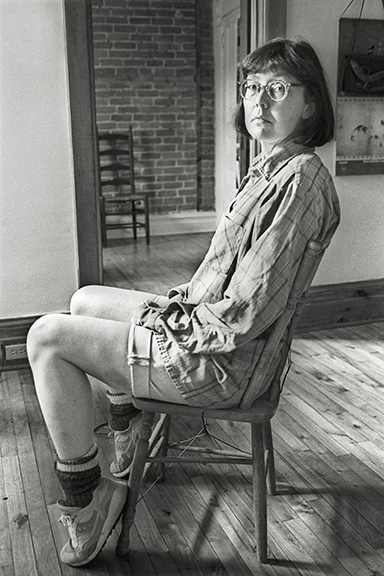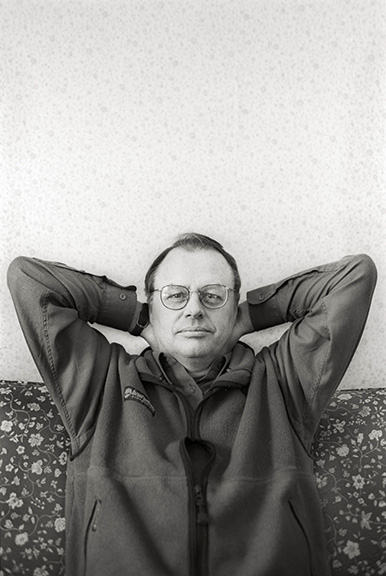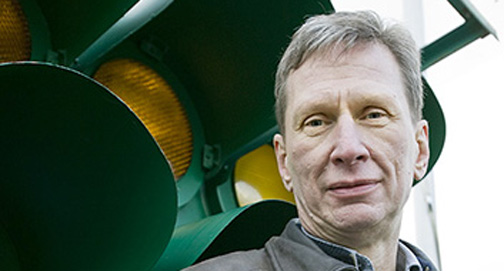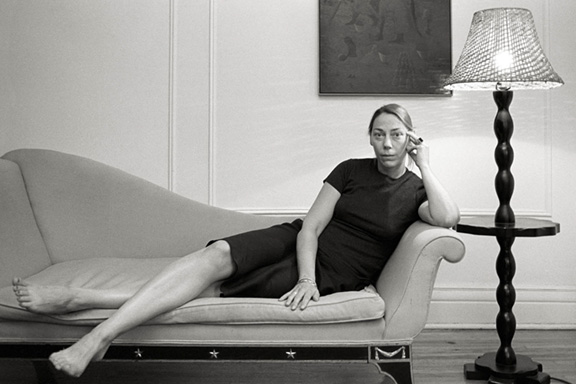Terence Byrnes
LP: You have been taking photographs for many years, what drew you to writers?
TB: Well, I’ve also been writing. My first collection of short stories was called Wintering Over, I published an anthology called Matinees Daily, wrote for many magazines, and, during a dark and busy period of my life, ghost-wrote other people’s books. I fessed up to that last bit in an article in Maisonneuve magazine called “My Life as a Ghost.” For the record, I began publishing in the late 60s. First poetry, then reviews in the so-called counter-culture magazines of the era like Rolling Stone, then fiction. Given this background, it might have been better to have asked how I could have avoided writers.
LP: Why did you include the quotation from photographer Irving Penn (“I can say that …I found pictures trying to show people in their natural circumstances generally disappointing”) at the beginning of your book since “people in their natural circumstances” accurately describes your images?
TB: Penn’s description of “natural circumstances” is actually pretty vague since he designed a portable daylight studio and shipped it to the locations of his more remote shoots. He may have meant that the idea of “natural” is actually a highly mediated one and that it can only be approached through the artificiality of staging. That, in any event, is the meaning I took from it.
Louis Dudek
LP: Was it a challenge to find a publisher for the book? Books of photographs are expensive to produce.
TB: Indeed they are. Other publishers have been enthusiastic about the project but have suddenly vanished from my In-box when they costed the project. However, Simon Dardick of Véhicule Press pursued the project with more enthusiasm, commitment, and greater skill than the others. We applied to the Canada Council and received support from both the Visual Arts section and the Writing and Publishing section. This was particularly pleasing because so much art that combines two normally distinct areas—like writing and image-making—isn’t very interesting in either area. The Canada Council’s support of both areas was a validation of the idea and of the work itself, as well as a financial necessity.
LP: Your comments on the difference between photographing men and women were interesting, essentially that women are more sensitive about photographs of themselves. Care to comment on that further?
Susan Gillis
TB: Sure, but the word “sensitive” isolates women in a way that makes me a little uncomfortable. I’ll turn the tables for a moment and say that society finds endless ways to valorize men despite the way(s) they look. Male slackers, nerds, slobs, sexual indiscriminates, bikers, and outlaws can all find a place on the ladder of sexual status that Hollywood and society in general deliver to us. The range for women is much narrower and so often refers to their sexual availability (or not). Consequently, women have to be more “sensitive” because they’re judged by a different, and less flexible, standard.
LP: You gave each writer the instructions that your photographs would be made “where they lived, worked, or played.” Why did make this request?
TB: First, pragmatism. When I was co-editing Matrix magazine, we were, like all literary magazines, broke. So I did the editorial photography when we interviewed or profiled an author. Often, that was at the writer’s home or favourite hangout. So the work developed from there. However, there was a proscriptive side to the shoots as well as a prescriptive one. Author photography operates in what I’ll call the “everyman” mode or the “frontispiece” modes. The everyman mode takes the easy, egalitarian road: a snapshot. The frontispiece mode starts to circle the author’s pate with the literary garlands of classical art. Historically, these “garlands” were a limited set of poses, many of which were derived from classical sculpture, and a familiar set of visual references that included busts of Shakespeare or Homer, staffs, literal garlands, open books, pens, and other devices. Now, we still use many of these signs of literary and social authority, but we’re also fond of bricks (the urban, the cool), books (unchanged for the last couple of thousand years) and computer screens (savvy). So, I also told each writer that we would avoid those clichés.
LP: The writers are all English speaking and you explain why. You like to talk with your subjects and your weak French would have interfered with that. It seems though that any decision to exclude one language or another in Quebec makes it a political or ethnic issue. Do you think so?
TB: Sure it is, but if we choose to look at it that way, our feet quickly become tangled in the terminology. For instance, Anglophones are, by definition, an ethnic group within Quebec, just as, let’s say, Filipinos or Moroccan are. Who would have been bothered by a book about Filipinos or Moroccans? However, I’ll stop myself from wading any further into that swamp. Closer to Home is not about Anglo writers in Quebec, and it’s not another dusty warehouse/museum/telephone book of candid author snaps, like People magazine with a lesser degree of celebrity and titillation. It’s about the representation of writers in a more general sense, and I’m most familiar with English-language traditions of representation. Also—and this is critically important—a strong sense of common ground and trust has to be created to make a shoot successful. Remember, I’m working very hard while talking. Accomplishing all this while speaking French would have been beyond my talents.
LP: The photographs in the book are all from Montreal, have you been photographing writers from other places as well?
TB: In a limited way, yes. However, if someone comes from Dublin or Chicago, stays in a hotel, reads in a public hall, and sits in a classroom, the opportunities for establishing anything but a documentary relationship between the figure and the setting are terribly limited.
LP: What do you find is the greatest challenge to a photographer creating portraits? Is it technical, is it personality, location or a combination of everything?
TB: May I just say “a combination of everything” and be let off the hook? If not, I’ll put the availability of useable light at the top of the list. Then comes personality. For instance, if the subject insists on being seen in front of a bookcase with fingertips grazing the temples in the Arcadian mode of calm repose, I’m sunk. There is, however, another element in the photographs that’s hiding in plain sight. I’m also a printmaker, and that part of me paints with light—to borrow a phrase from Ansel Adams—on the computer. The camera does not see as the eye does; that re-creation must be accomplished by the printmaker.

Anne Carson
LP: Do you crop your images when making prints or do you print them full frame (i.e., everything that was on the original negative or digital capture).
TB: Except for tiny bits of trimming around the edges, the vast majority are full frame. There are a few exceptions—Rawi Hage and Norm Sibum, for example. The whole full-frame thing is interesting, though, because it links to a naïve notion about the authenticity of the “documentary” image. That is, cropping is associated with lying. It’s nonsense, though. One of the first principles of all art is that of selection, and a full frame is as much of a selection as a partial frame.
LP: Montreal has a great tradition of documentary photographers. Were/are any of these photographers and their work influences on you?
TB: I wonder who you have in mind. Sam Tata? Gabor Szilasi? Louise Abbott? Serge Clément? Of course, with Serge, we’re drifting quite far past the borders of the “documentary,” but if I had to make a link, it would be with his work. He’s a very fine artist.
LP: Scanning other books on the market that showcase writer portraits reveals that they are all black and white images. You photographed originally with black and white film but now shoot digital images so have files in colour but choose to print everything black and white. What is it about black and white photographs and images of writers?
TB: There are playful and speculative answers that might nevertheless have some weight. I could say that pre-20th century frontispiece portraits are black on white, or that we see Eliot or Faulkner, or Stein primarily in black and white, and that current representation wishes to borrow from that historical authority. That has some truth in it. Also true is the fact that the colour in an uncontrolled environment can be very distracting. Colour can also make it more difficult to design a coherent frame.
LP: What makes you include or exclude details from a photograph? Your photograph of Sheila Fischman has space (walls) around her but that space is filled by photographs and mirrors while in your photo of Trevor Ferguson almost half the space is taken up by a blank wall?
TB: Trevor’s wall isn’t blank! It’s filled with patterned wallpaper that works with the patterned couch he’s sitting on. The figure is then isolated by a ground of pattern. That’s one of those designed frames I was talking about. The image of Sheila is intended to speak directly to the written text, which is about memory, loss, and reflection.

Trevor Ferguson
Sheila Fischman
LP: You include a short description of your visit and photo session with each writer. Was it difficult to keep each piece so short? I assume that with at least some of the writers you could have written several pages about the session.
TB: The short descriptions were intended to function in ways that paralleled the function of the photographs. Like the photographs, they describe a point (or points) in time. They are suggestive of personality (of the writer-photographer as well as of the subject), and they may at times contradict the implications of the image. The idea is that neither mode communicates anything like an essential truth about character, that both are representations, that the writer being portrayed is the object of different kinds of gaze. The book, as an idea, at least, is a function of both text and image.
LP: Are your personal favourite photographs based on the image or the session/relationship with the writer?
TB: On the image entirely. I left each shoot (there were over a hundred) cursing myself for opportunities missed and technical things done poorly. I cursed myself again when I saw the failures of the negatives or the digital captures. There were only a few times when I looked into the viewfinder, immediately knew I had something good, and got it. Those were the times when I knew there was something more than chance at work in this enterprise of making photographs.
Stephanie Bolster
LP: Will we be able to see any of the photographs in an exhibition soon?
TB: The work has been exhibited a number of times already but the show has not travelled widely. Art exhibitions face the same problems as art book publication: they’re expensive. If the book had been conceived and marketed as the kind of collection that I dismissed earlier as a “warehouse,” there would probably be more interest in another show. Viewers and funding agencies like work that claims to speak of a locale or a people. My only claim for the photographs and written portraits in Closer to Home is that they speak of representation itself.
LP: Is this an ongoing project or does the book signal the end of this group of photographs?
TB: It’s an end.
Terence Byrnes book of writer portraits Closer To Home is published by Véhicule Press
Terence Byrnes’ work can bee seen at this website: www.springfieldfolio.terencebyrnes.com




